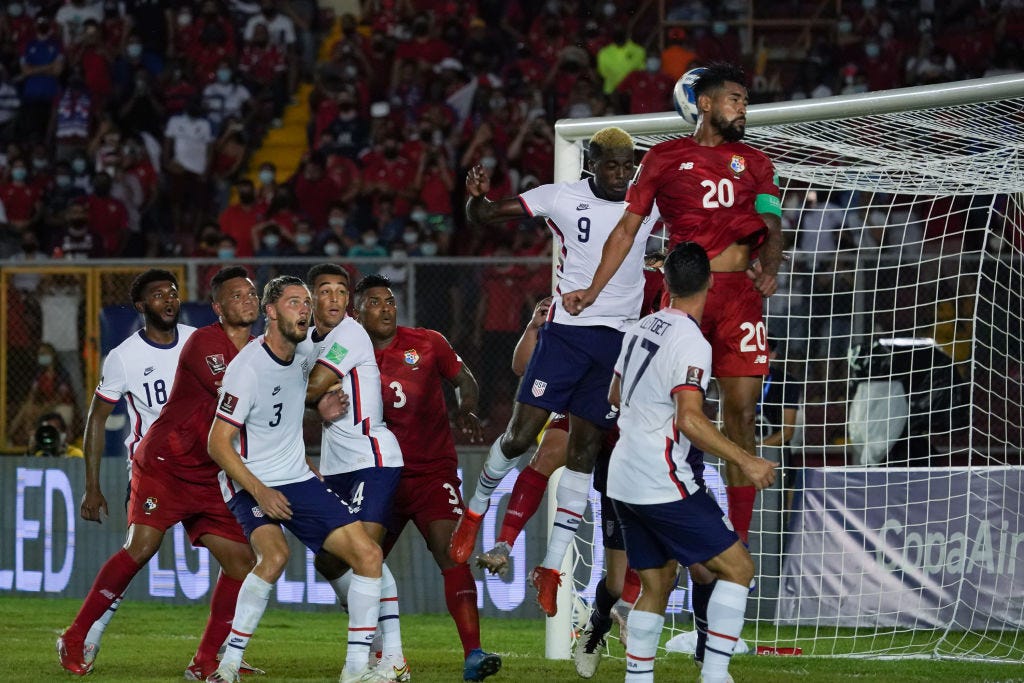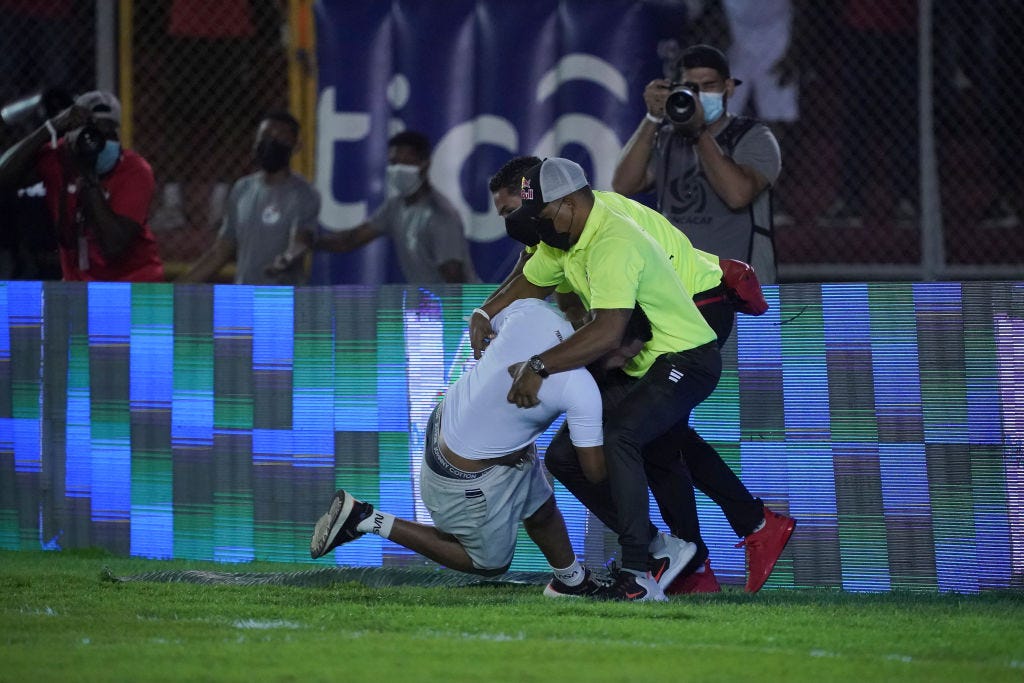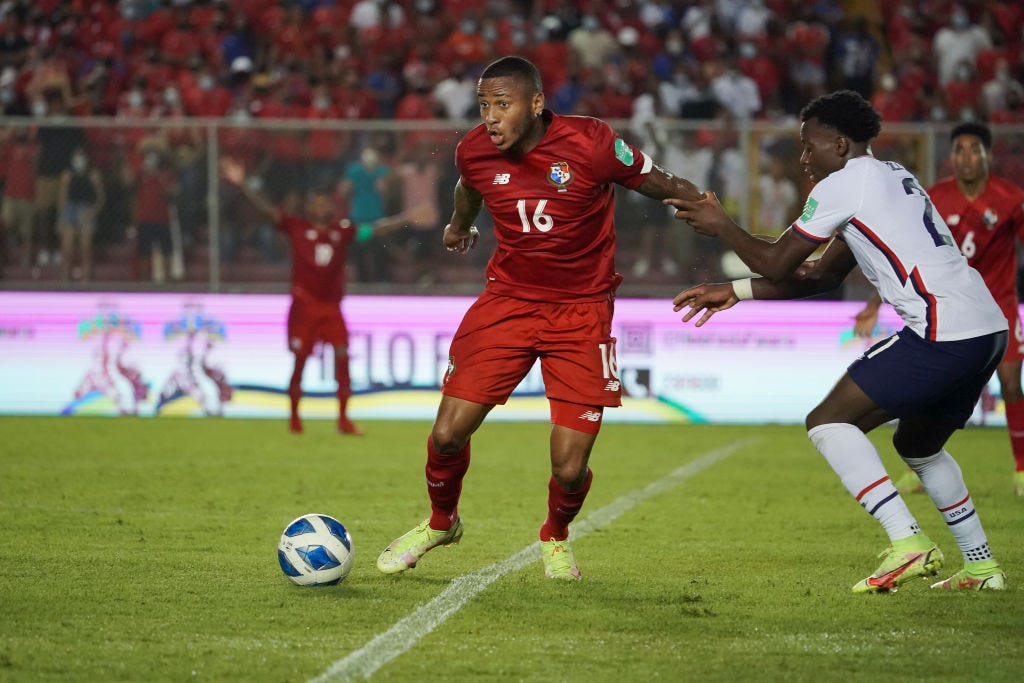Premium: Wounded in Panama
The USMNT Loses Its First World Cup Qualifier of the Cycle in a Game Nobody Will Give a 10/10

Welcome to Fútbol with Grant Wahl — a newsletter about soccer. You can read what this is about here. If you like what you see, consider forwarding it to some friends. You can also click the button below to subscribe for free and receive every free post in your inbox the second it’s published. And if you do like it, consider going to the paid version to receive every post. I also wrote My 3 Thoughts on the Panama-USMNT game at the final whistle. You can subscribe for free to the Fútbol with Grant Wahl Podcast, including our Panama-USMNT breakdown with Landon Donovan and Chris Wittyngham, in partnership with Meadowlark Media and Le Batard and Friends.
PANAMA CITY, Panama — Yet another October 10 has come and gone, and it has become clear that for USMNT fans, at least, 10/10 feels like the crushing opposite of what the expression “10/10” means for most people.
October 10, 2017, certainly wasn’t a 10/10 occasion in the latter sense, but rather the darkest day in American soccer history, when the U.S., needing just a tie, lost at Trinidad and Tobago and failed to qualify for World Cup 2018. And like some cosmic curse, October 10, 2021, turned into perhaps the USMNT’s worst day since the 10/10 four years earlier, thanks to a 1-0 defeat at Panama in World Cup qualifying that was as ugly as it was self-inflicted.
That’s not to demean the hosts, who brought more intensity than their opponents, took four shots on goal to the U.S.’s zero, had more expected goals—0.88 to 0.22, the lowest of U.S. coach Gregg Berhalter’s tenure by 0.31—and found the net on a far-too-easy 54th-minute corner-kick header by Aníbal Godoy (which took a helpful deflection off the head of Gyasi Zardes). The hosts also performed some top-shelf CONCACAFing, from time-wasting to fans running on the field to ball boys in one moment kicking spare balls under the stands and in another lobbing extra balls onto the field during play near the end.

It’s also worth noting that October 10 is the most joyous of days for soccer fans in Panama, not just for Sunday’s historic win, but also because the U.S. fiasco that night four years ago meant that Panama qualified for its first World Cup. In the zero-sum game of international soccer, one country’s curse is another’s national holiday.
So why did this U.S. loss, coinciding with a punchless performance, feel preventable? Simple: Berhalter chose to make seven changes in his starting lineup from the one that beat Jamaica 2-0 on Thursday. He chose to sit central midfielder Tyler Adams, the team’s most indispensable player, even though Adams went 90 minutes in all three games last month and has the fitness of a triathlete from playing at non-stop Leipzig. He chose to sit center forward Ricardo Pepi, who had been in the zone like few U.S. players ever in World Cup qualifying, and Brenden Aaronson, the most dangerous U.S. winger in the absence of Christian Pulisic and Gio Reyna, even though Pepi and Aaronson came out midway through the second half on Thursday presumably to save energy. (All three players would come on in the second half in Panama.)
What’s more, he chose to sit Miles Robinson, the team’s most reliable center back, and Sergiño Dest, the U.S.’s best fullback, for the entire 90 minutes. Look, some rotations were unavoidable when you’re playing three games in seven days, but the sheer quantity of talent that Berhalter left on the bench was excessive. He put too much trust in his depth and underestimated his opponents in the process. And the U.S. paid the price with its first loss ever to Panama in nine World Cup qualifiers. The defeat left the U.S., with eight points, in second place after five games, behind Mexico (11) and ahead of Panama (eight) on goal difference.
“We’re playing in extreme heat and extreme humidity,” Berhalter said afterward when asked about all the changes. “We know we traveled four and a half hours, and we know that we have another game on Wednesday, and we wanted to rotate players. And if it didn’t work, then it’s on me.”
When I asked Berhalter specifically about not starting Adams, Pepi and Aaronson, he said he planned to get 45 minutes each out of Aaronson and Adams, adding that he thought Adams’ missed games with Leipzig not long ago due to a minor injury meant he didn’t feel comfortable using him for 90 minutes in three straight qualifiers. Berhalter didn’t answer the part about Pepi.

Queried later about whether he had made too many changes, Berhalter said: “Now it obviously doesn’t look like the best choice. But I think we have to wait until Thursday, because if we would have played the same players from the last game … I’m not sure we would position ourselves in the best way to win again on Wednesday. We had to make, I guess, a somewhat risky decision. And the good thing is we’re still in second place, right?”
That’s true. But the bad thing is this: Without Adams and Weston McKennie, who was out with muscle soreness, in the central midfield, the U.S. looked disjointed, sloppy and lacking in creativity in that part of the field with a trio Kellyn Acosta, Yunus Musah and Sebastian Lletget. As noted by Paul Carr, the director of content for TruMedia, those three completed only 11 passes to each other in the first half, compared to 36 by Adams, McKennie and Musah in the first half of the Jamaica game.
“Panama did a good job spreading us out, and we didn’t get our spacing right,” said Acosta, who was still wearing a head wrap from banging heads with Panama’s Armando Cooper in the second half. “We weren’t in good positions with the ball. We weren’t great with the ball. You could blame all the different variables of the game, but at the end of the day we just weren’t good enough as a team. It was a poor performance by me. Being in the middle of the park, I’ve got to be the cog, and it just wasn’t good enough.”

Conceding the Panama goal on a set-piece—usually a U.S. strength at both ends of the field—only compounded the misery. Panama had tested U.S. goalkeeper Matt Turner in the first half by nearly scoring Olímpicos (goals directly from corner kicks) on two occasions. And it was another inswinging corner close to goal that Godoy nodded in for the game-winner.
“Crowded six-yard box, a bunch of heads flying up for the ball,” said Turner afterward. “Credit to them. They had some good service on their set-pieces. It was clear what they were trying to do. Just a quick flick, and it was by me before I even knew it. So it was a good goal. They obviously had been practicing that, and we weren’t up to the task. It’s frustrating to lose, especially on a set-piece, but at the end of the day we didn’t do enough in the final third to give ourselves a chance to win.”
The downside of the unexpected defeat is that it shifts the discussion away from the positive vibes that were surrounding the U.S. after two straight victories in qualifying. But the reality is that many of the gains inside the team have taken place over a period of time and won’t be erased by one stinging loss in Panama. Indeed, those gains will be critical through a qualifying process that runs through next March and is certain to have more ups and downs over the nine remaining games.
Berhalter appears to have succeeded so far in his nearly three years on the job in fostering a team culture in which the diversity of the United States as a country and the American international diaspora are assets and not liabilities. That’s no small feat. Rightly or wrongly, the USMNT under Jürgen Klinsmann, especially during his three years after World Cup 2014, was viewed by some players to have been divided between several of the players who were German Americans and those who weren’t. Under Bruce Arena during the failed World Cup qualification in 2017, the USMNT was again divided internally, this time between European-based players and MLS players, one of those Euro-based players, Geoff Cameron, later wrote in The Players’ Tribune.
Over the years, the USMNT under various coaches has failed to incorporate many Mexican American players despite the large and growing Mexican American soccer culture in the U.S. (Bob Bradley bringing José Francisco Torres and Hérculez Gómez to World Cup 2010 was an anomaly.) And for much of the past 30 years, the U.S.’s largely white, middle- to upper-middle-class soccer culture was reflected in the small number of Black Americans on the USMNT.
That’s starting to change now. While Pepi has played only three games with the national team, his decision to represent the U.S. over Mexico was a big one, and as a goal-scorer he has the chance to become a transformative figure, perhaps the USMNT’s first Mexican American superstar. And of the 21 U.S. players who’ve gotten on the field in the last two games, 13 are Black.
As Berhalter has built a team culture of young U.S. players from some of the world’s top clubs, he has been able to win recruiting battles for a new type of dual-national: one who doesn’t just choose the U.S. mainly because he can’t get on the field with a more established soccer country, but rather one who turns down real playing opportunities with traditional powerhouses to opt for the U.S. No players fit that description better than Barcelona 20-year-old Dest, who could have represented the Netherlands, and Valencia 18-year-old Musah, whom England wanted. Both have had an impact with the USMNT.
Team culture matters. In a revealing behind-the-scenes video released by U.S. Soccer on Sunday morning, Berhalter is shown welcoming the team in its entirety for the first time in Austin last Tuesday. The PowerPoint slide on the board behind Berhalter reads:
OUR MISSION
To create a team:
• That can win against the elite of international soccer.
• With a clearly defined “identity” (how we play + our team culture).
• We embody our Anchors on/off the field.

We’ll leave the “Anchors” discussion for another day. (A U.S. Soccer spokesperson told me: “We have three team ‘anchors’; they aren’t external-facing at the moment.”) But if you ask the players, the team culture part is going well. Are there any divides due to geography in the current USMNT like the ones under Klinsmann and Arena?
“Definitely not,” 21-year-old defender Chris Richards—one player who has surprisingly yet to play in this window—told me in a one-on-one interview. “It’s cool because you go around the locker room and you’ll hear an English accent [Musah and Antonee Robinson], you’ll hear a German accent [John Brooks], you’ll hear a bunch of different stuff, and that’s what I think makes us such a great team. It’s just the diversity.”
Richards went on: “Sergiño’s pretty much Dutch. Yunus has lived in England for most of his life. Antonee as well. John is of course German American. Even though we come from these different places, we all can relate to each other. I think that just kind of makes us all stronger in the end. It’s cool to see the diversity, and we’re all fighting for the same thing. So who are we to discriminate against each other because of where you’re born or where you grew up?”
The biggest recent challenge to the U.S. team culture was the situation last month when McKennie, the Juventus star and normally a lock in the midfield, was sent home in the middle of World Cup qualifiers for violating team policy, missing two games. When McKennie was called back into the U.S. fold this month, he could have sulked. But he didn’t. Last Wednesday when I asked Brenden Aaronson what had stood out to him in training, the first player he mentioned—without any prompting—was McKennie. “Weston looks ready to go,” Aaronson said. “That’s the one name that comes out to me.”
Instead of hiding, McKennie was “running a pool tournament at our hotel and running a few of the guys for their per diem money,” Richards told me with a laugh. “Sergiño came in and wanted to play by his own rules, and I don’t know how you can switch around rules for pool, but somehow he found a way. Sergiño is a different guy.”
The team’s COVID protocols have been difficult at times, but they've also forced players to get to know a few teammates better in ways they might not have expected. With players eating their meals in the same four-person pods for the entire camp, Richards said he has enjoyed learning more about his pod-mates Aaronson, Tim Weah and Sean Johnson.

“I knew Timothy from the Under-20 World Cup cycle, and Brenden I knew a little bit, but I’d never met Sean before,” Richards said. “So even though it wasn’t necessarily the table I would have chosen, I like it because it’s guys who I get to learn about from different parts of the U.S., and just hear different things that they’ve been through.”
Now in World Cup qualifying, these U.S. players aren’t just hearing about previous experiences from their teammates; they’re experiencing important moments together. How they’ll respond this Wednesday in Columbus against Costa Rica could very well dictate the tenor of the rest of the tournament. After all, the most impactful U.S. defeat in qualifying four years ago wasn’t the game in Trinidad and Tobago. It was the home loss to Costa Rica.
Another home qualifier with Costa Rica awaits in two days. And at least it won’t be taking place on 10/10.
If you read this newsletter and value it, consider going to the paid version. Doing quality soccer journalism and becoming sustainable requires people being willing to pay for it. If you’re reading this in your inbox, you can find a shareable version online here. You can follow me on Twitter here and Instagram here. Feel free to comment below, and thanks for reading.





Thank you for the article, Grant. It’s nice to read your analysis that isn’t as hysterical as most of the analysis I’ve seen surrounding USMNT. I really enjoy being a subscriber.
Great read, Grant. Calmness in the face of chaos is a virtue. But your reply below is right on. If they win Wednesday, pressure’s off 3G. If they don’t, the heat gets turned up to boil.
Costa Rica are the kings of packing it in. And Keylor Navas is still between the sticks. I sure hope they didn’t basically throw that game away only to struggle in this one.